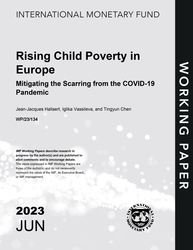
Rising Child Poverty in Europe: Mitigating the Scarring from the COVID-19 Pandemic
Rising Child Poverty in Europe: Mitigating the Scarring from the COVID-19 Pandemic
READ MORE...
Volume/Issue:
Volume 2023
Issue 134
Publication date: June 2023
ISBN: 9798400244896
$20.00
Add to Cart by clicking price of the language and format you'd like to purchase
Available Languages and Formats
| English |
Prices in red indicate formats that are not yet available but are forthcoming.
Topics covered in this book
This title contains information about the following subjects.
Click on a subject if you would like to see other titles with the same subjects.
Economics- Macroeconomics , Public Finance , Economics / General , Public Policy - Social Services and Welfare , Poverty and Homelessness , child poverty , EU assistance , scarring effect , C , measuring poverty , summary plot , labor income , COVID-19 , Income , Poverty reduction , Social protection spending , Europe
Summary
Child poverty increased dramatically during the COVID-19 pandemic. In 2020 alone, the number of children suffering from poverty in the EU increased by 19 percent, or close to 1 million. Left unaddressed, this would not only affect individuals’ life prospects and well-being but also have long-term economic implications. This paper argues that, to limit this potential scarring effect of the pandemic, policies should be deployed to reduce rapidly the number of children affected by poverty and mitigate the long-term impact of poverty. Reducing the number of children affected by poverty can be achieved by (i) labor policies and reforms that increase parental work and the labor income of poor parents and (ii) fiscal spending on family and children that can have a powerful and immediate impact. These policies need to be complemented by public investment in education and childcare, health, and housing to mitigate the long-term impact of child poverty.
Copyright © 2010 - 2025
Powered by:
AIDC



